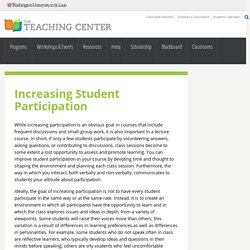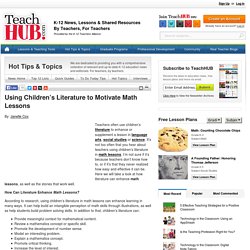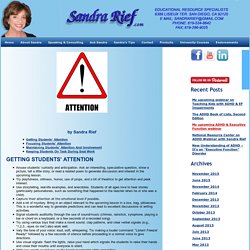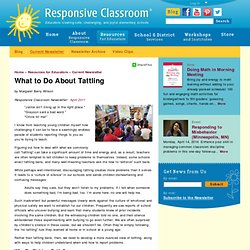

Rosenshine. Shaping the Learning Environment Connecting Developmentally Appropriate Practices to Brain Research. Increasing Student Participation. While increasing participation is an obvious goal in courses that include frequent discussions and small-group work, it is also important in a lecture course.

In short, if only a few students participate by volunteering answers, asking questions, or contributing to discussions, class sessions become to some extent a lost opportunity to assess and promote learning. You can improve student participation in your course by devoting time and thought to shaping the environment and planning each class session. Furthermore, the way in which you interact, both verbally and non-verbally, communicates to students your attitude about participation.
Ideally, the goal of increasing participation is not to have every student participate in the same way or at the same rate. Popsicle Sticks. Using Children’s Literature to Motivate Math Lessons. Teachers often use children’s literature to enhance or supplement a lesson in language arts, social studies or science.

It’s not too often that you hear about teachers using children’s literature in math lessons. I’m not sure if it’s because teachers don’t know how to, or if it’s that they never realized how easy and effective it can be. Here we will take a look at how literature can enhance math lessons, as well as the stories that work well. How Can Literature Enhance Math Lessons? Offering Choices to Students. EducationWorld is pleased to present this professional development resource shared by Dr.

Jane Bluestein, an expert in relationship-building, positive school climate and effective instruction. Like boundaries, choices are motivational tools that encourage young people’s cooperation through empowerment. Closure. Closure should come from the students stating what they learned during the class.

The intellectual work should be done by the students and not by the teacher. Oftentimes, teachers leave off the closure. It is the first thing to get cut off if time is running out at the end of the lesson. Closure Information1. t11 providingh2. Descriptive feedback stems. Pinterest. Engaging & Maintaining Students’ Attention. By Sandra Rief Arouse students’ curiosity and anticipation.

Ask an interesting, speculative question, show a picture, tell a little story, or read a related poem to generate discussion and interest in the upcoming lesson.Try playfulness, silliness, humor, use of props, and a bit of theatrics to get attention and peek interest.Use storytelling, real-life examples, and anecdotes. Students of all ages love to hear stories (particularly personalones, such as something that happened to the teacher when he or she was a child).
Capture their attention at the emotional level if possible.Add a bit of mystery. Bring in an object relevant to the upcoming lesson in a box, bag, pillowcase. Keep students actively engaged. This article is excerpted from Sandra’s books published by Jossey-Bass/Wiley: The ADD/ADHD Checklist: An Easy Reference for Parents & Teachers, 2nd edition (2008), How to Reach & Teach Children with ADD/ADHD, 2nd edition (2005), and The ADHD Book of Lists (2003). Culturally Responsive Strategies to Support Young Children With Challenging Behavior Article. Psibehaviorspecpraise. BehaviorManagement ImportantFacts. ClassroomManagementTips. Express 11.02 - Capturing Students' Attention with Compelling Hooks. Capturing Students' Attention with Compelling Hooks Craig Simmons Captivating students is not always easy.

In fact, it is often one of the most difficult tasks a teacher has. With the latest technological gadgets and video games competing for their interest, capturing students' attention is critical. Comprehension Skill: Draw Conclusions. Njea. Cindy, a well-educated, highly qualified and recent college graduate pursuing a fourth-grade teaching position, offers a common response to the principal’s interview question, “How do you plan to manage your classroom?”

Cindy confidently responds, “I plan to develop a system where students will earn points for good behavior during the week and any student who earns a predetermined number of points will receive tickets to enter a raffle for prizes at the end of the week.” Like Cindy, thousands of graduates from teacher education programs across New Jersey excitedly prepare for the job search in hopes of landing a teaching position in this difficult job market. During these interviews, prospective teachers will undoubtedly be asked a question or two about classroom management. Responsive Classroom. Your Secret Weapon: Wait Time (Professional Development Teaching Advice, Grades K-12)
Listen in on many classrooms at all levels, and you'll probably hear teachers asking question after question.

With so many questions coming at them, students have little time to think. Looking at it another way: the more questions that are asked, the less thinking occurs. Classroom observations reveal that teachers typically wait less than 1 second for students to respond to a question. Teachers often conclude that students don't know the answer to a question if they don't respond quickly. And when they do respond, they usually use knowledge-level responses.
Establishing Classroom Rules and Expectations the First Week of School is Crucia. Sticking With Students: Responding Effectively to Incorrect Answers. Proximity and Mobility - Top Ten Strategies for Classroom Management and Discipline. Proximity and Mobility Goofing off in the classroom is inevitable in every classroom regardless of how much experience a teacher has.

However, there are specific strategies that teachers use to maintain off-task behavior and that is the use of Proximity and Mobility. The picture below is a simple layout in an avearge math class. The "x" represents a teacher helping a student. 356cdcd3-0990-4433-ab6a-4a83ff8afe13.doc. The Main Idea - The Highly Engaged Classroom.Pdf.
Classroom Management - perhaps good to share with the pre-service students in your school who might be struggling... - Outlook Web App, light version. What to Do About Tattling. "Jaime isn’t lining up in the right place.

" "Grayson said a bad word. " "Olivia hit me! " Guided Reading Guru / Guided reading lessons for grades K-6. DEVELOPMENTAL JOURNALING and REFLECTION. Lesson Planning.